An excellent place to learn is the page that started it all for me: www.dpfwiw.com/ir.htm
Some artists whose works in IR I admire are
Daniella: www.pbase.com/zylen
Melanie Kipp: www.caughtintimephotography.com
Luben Solev: www.solev.net
Andy Williams:www.moonriverphotography.com
If you do not like their IR photography, I am quite sure that you'll not like it at all.
Meeting point for digital and analog IR photographers: www.irphotoforum.com
But now to my own words & pictures. ;)
The following sections can be found on this page:
- What is IR?
- Heat radiation? Infrared?
- Why should I want IR photography?
- Can I use every digital camera for IR photography?
- What can I do to shoot IR photos?
- How can I detect whether my camera can do IR?
- I have a dSLR, what about those?
- I have an analog camera, what can I do?
- What about the other side of the spectrum, UV photography?
IR stands for infrared and is the name of a certain "colour" of light. Everyone knows that there are different colours of light. What less people know is that the "white" light the sun sends to us includes all the colours human beings can see: From the reds over the yellows and greens to the blues. However, science does not measure the type of light in colours. Instead, the wavelength lambda is used, measured in nanometers (nm).

A general sine wave without units
But the sun emits more light than our eyes can see, which is about 400nm (blue) to 700nm (red). (1nm is 1/1000 of a micrometer, 1micrometer is 1/1000 of a millimeter, 1millimeter is 1/1000 of a meter, therefore 1nm is 1/1000000000 of a meter!) The ultra-violet rays that create sunburn are one example on the "blue end" of the spectrum. On the "red end", there is infrared light.
If you want to learn more about the spectrum we can see in relation to what the sun emits, you should visit www.rwc.uc.edu/koehler/biophys/6d.html
However, when the infrared area of the spectrum was discovered, the name "infrared" was applied to everything between the visible red light and the radio waves. Later it became obvious that light in this large section shows significantly different properties. Therefore nowadays, IR is devided into near Infrared (nIR) and far Infrared (fIR). Sometimes the term "intermediate Infrared" shows up, but from my personal experience, it is uncommon. Far Infrared is synonymous to heat radiation. A very excellent resource is
www.wmin.ac.uk/itrg/is/msc/adi_lecture3_IRa.pdf
It deals with nIR, fIR and heat, covering photographic and thermal imaging use.
The CCD chip is very sensitive to visible light and near IR light. As a proof, you can download a pdf file from Sony describing the spectral sensitivity of their monochrome camera modules often used for science, like the ICX255AL or the ICX259AL:
www.sony.co.jp/~semicon/english/img/sony01/a6805274.pdf
www.sony.co.jp/~semicon/english/img/sony01/a6805278.pdf
As you probably can see, the sensitivity is very similar independent from the specific CCD sensor. It is therefore possible to photograph this light with any CCD sensor. CMOS sensors are in fact very similar, watch this pdf from www.pulnix.com:
www.pulnix.com/PDFs/IMG-PDFs/OEM-only/PC-640CL.pdf
In case you do not want to read all these pdfs, here is my summing-up:
Sensors of digital cameras are most sensitive around 550nm and extend their sensitivity to the near UV and near IR spectrum (up to 1000nm with low sensitivity). Specialized scientific cameras have different properties like this one from Hitachi:
www.hitachi-service.net/kp-f2/kpf2.htm
with a peak sensitivity for 750nm!
To capture the far IR (beyond about 2000nm up to 1mm) is impossible with standard cameras. It takes very specialized (read: very expensive) equipment to do that. Instead, the infrared photography that is possible with digital cameras is always nIR. Often people address me and want to know if my camera can "see" heat. The answer is: "Not really!" The IR light the camera sees is normally reflected from objects, just like visible light is.
However, there is one occasion, when nIR and fIR cannot be separated easily. This is when a very hot, glowing or almost glowing subject is photographed with a camera that can see IR light.
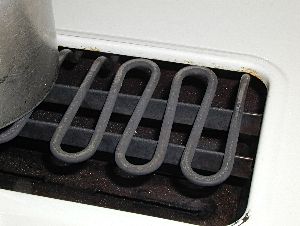
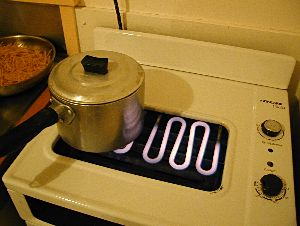
First one taken with flash shows heating spirals (the flash overpowers the emitted IR light!).
Second one using available light.
Shot with an unmodified Olympus 2020 without additional filter.
The heater is already very hot and naturally emits fIR in spades. However, there is also much nIR and the Olympus 2020 I used can see that.
Michael Fulks from
www.apogeephoto.com/mag1-1/mag1-IR.html
presents a separation of the IR spectrum that is very useful. Interestingly (I haven't seen this elsewhere!), he uses four different areas of IR light. I started from there and built the following table. "Actinic" means "photochemically active", whereas "calorific" means "connected to heat".
| name | example | capturing by |
| actinic range | light from the sun or light bulbs reflected by objects | with CCD sensors very easily |
| hot body | emitted by hot irons and similar objects between 200°C and 400°C | with CCD sensors easily |
| calorific range | emitted by objects between 100°C and 200°C | special equipment |
| warm range | emitted by the human body and all objects warmer than -273.15°C (absolute zero) | special equipment |
Because it offers totally new artistic and scientific possibilities. Human eyes cannot see Infrared light. As infrared light has different characteristics than the visible light we can see, IR photography is not only capturing the "invisble", the pictures also have a very different look to them. Apart from the "artistic" use I'll try to describe, I can recommend msp.rmit.edu.au for use of IR in scientific and medical applications.
Now, some examples of the differences between visible light an IR:
-
Leaves of plants are bright white because they reflect most of the infrared light. This is to protect the plant from overheating.) This effect is quite difficult to handle. Even leaves that are in the shadow can be pretty white and leaves that are in the direct sun are extremely bright. So you might have problems getting the exposure right.
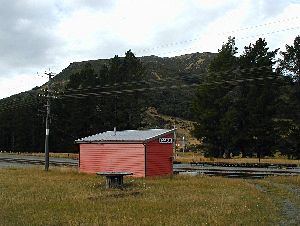
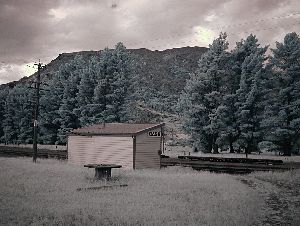
Taken with my 2020 and automatic white balance (AWB), Hoya R72 (720nm) used for the IR shot.
No postprocessing except resizing and USM (unsharp mask).
These settings were used on all the example pics here unless otherwise noted.
Note that these trees are pines. Needles seem to reflect less light than leaves.
-
A blue sky is dark in IR light because naturally, blue light does not have much red in it.
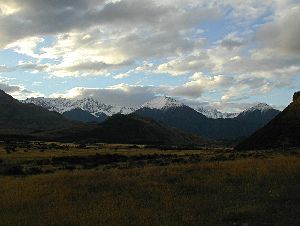
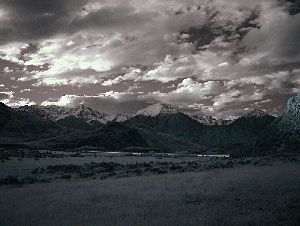
Not only is the sky darker which creates a menacing effect (but can be partly lessened in post-processing by swapping red&blue), but the contrast is enhanced. However, both shots are underexposed to capture the evening feeling.
-
nIR cuts through haze when it consists of particles like fine dust. However, water in any form, be it liquid, vapour or gasous blocks IR partly.
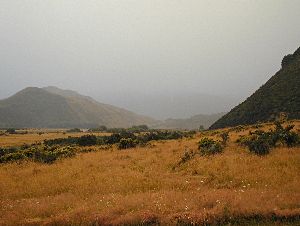
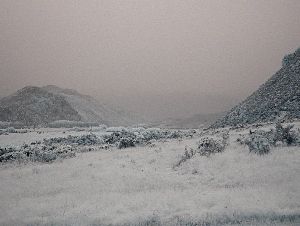
This shows a very foggy early morning in Cass, New Zealand. Eventhough IR is said to be blocked by fog (water droplets), the IR picture is IMO better than the visible light photo.
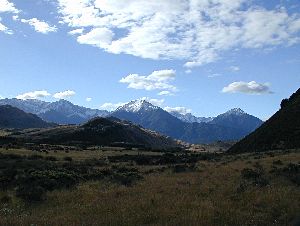
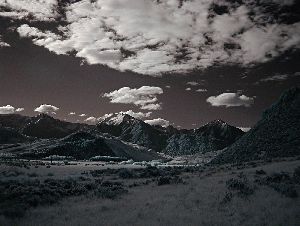
On a sunny day, it is less fog, but more haze. The IR photo shows much more detail.
-
IR light does not penetrate deeply into water, as can be seen in Daniella's photos of the pool of the Castle by the Sea. I do not have a picture showing this clearly, yet. But I have these shots showing how black a blue lake appears in IR:
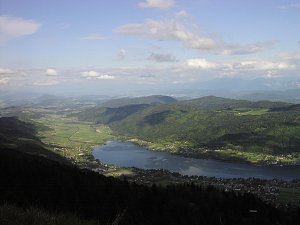
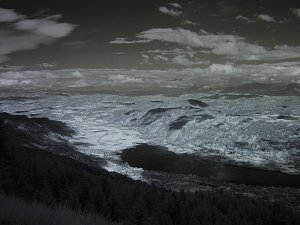
Note: IR shot done with a modified camera: 2040IR
-
black is not always black: Eventhough two colours may seem identical in visible light, their reflecting properties might be totally different in infrared light! See these two pictures of my former mountainbike:
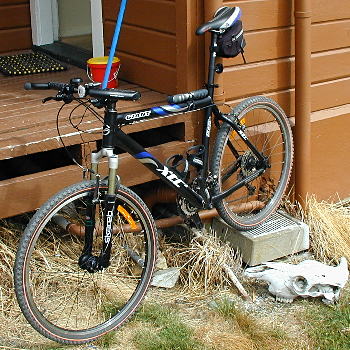
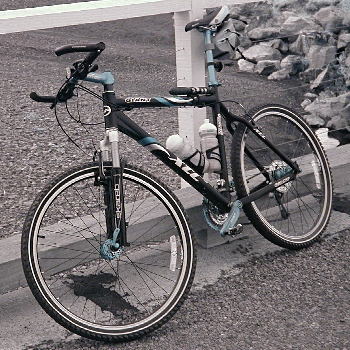
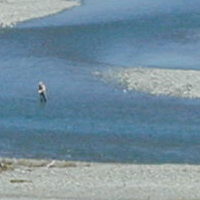
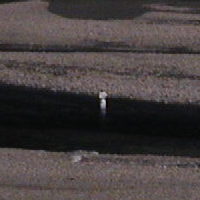
This shows a fisher in the Waimakariri river in New Zealand, full size crop from 2.1MP.
Near Infrared photography can be used to show environmental pollution and the state of plant health for example. (I think fIR can be used for this, too.)
Please note that sometimes the opposite is true. Two colours seem totally different in visible light but in IR photos they are almost indistinguishable!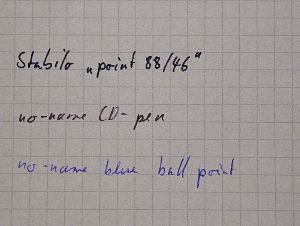
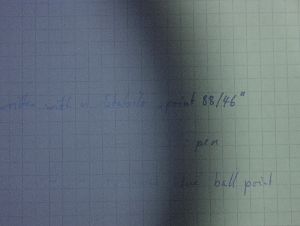
left one taken in visible light with my 2020, right one with a 715nm IR pass filter partly in front of my Olympus 2040IR. You can see that while the upper writing remains visible, the other two nearly disappear.
No. While every CCD sensor can see nIR, cameras are far more complex. To understand what is happening, you have to know something about the way digital cameras perceive the light. A single sensel (mostly called pixel which is wrong, it should be sensor element, pixel is for picture element) cannot see colours. It just tells the processor of your camera: "Hey, I have seen that and that much light." This is the way black&white cameras work. But for colour photography you cannot use just a CCD chip. Instead, there are filters in front of each of the CCD sensels. Some of them let only red pass, others green and yet others blue. If this reminds you of the RedGreenBlue code for monitors and other graphics stuff you are right. So, when a sensel behind the green-pass filter says: "Hey, I have seen that and that much light." the processor knows that the colour of the light the sensel saw was green. By combining this info with those from surrounding sensels with differently coloured filters, your camera can see colours. So, ideally, these filters would be infinitely sharp. This way the computer in your camera knows, that a green sensel only sees green and not a single bit of red or blue. This is not possible in the real world. However, as the digital signal processor in your camera knows the characteristics of each filter element, this is not a big problem.
You can see a non-typical spectral sensitivity diagram of a Sony colour-chip here:
products.sel.sony.com/semi/PDF/ICX252AK.pdf
It is non-typical because Sony uses a Green/Cyan/Magenta/Yellow filter array on many of their cameras. However, Sony of course also manufactures typical RGB filter array CCDs. The above mentioned ICX252AK is called ICX252Q for the RGB version:
products.sel.sony.com/semi/PDF/ICX252AQ.pdf
According to the useful resource page www.molon.de/5050.html the ICX452AQ CCD sensor is the one used in the Olympus 5050. It is often difficult to find this info.
Now, concluding this section I'd like to present you the datasheet pdf www.imagelabs.com/pdf/CV-L105_db.pdf of an industrial use digital camera. By the use of a prism, the light beam gets devided into its colours. For each of the RGB colours there is one single CCD sensor. So, you have three CCD sensors in one camera. (This principle is also used in some digital camcorders.) The camera is manufactured by www.jai.com.
But back to consumer digicams. What indeed is a problem is that eventhough the filters let only either "green" or "red" or "blue" light pass, they also let nIR pass. This can be seen in the charts in the above pdf document: The sensitivity of the Green/Cyan filters climbs again at wavelengths of around 700nm. Now, the processor in your camera has a problem: It does not know how much of the light a sensel reports is "green" and how much is "nIR". The result is wrong colours. To remedy this, all cameras but the very cheapest have an IR-cut filter in front of the CCD. This piece of usually flat glass lets only visible light pass. Once again, no filter is perfect, so even with this filter every camera can see a bit of IR. How much depends on the strength of the used filter. So, even with the data sheet from Sony or whomever, you can only predict the IR sensitivity of a modified camera with the internal IR cut filter removed: The datasheet lists the sensitivity for CCD+colour filter array, but does not include the IR blocking effect of the IR cut filter.
In the beginnings of digital photography, manufacturers were not that aware of the problems nIR "pollution" can cause to normal, visible light, photography. So, for example the Olympus 2020 and the Nikon Coolpix 950 are both cameras which see relatively much IR. While this is good for me and other IR lovers, it can create problems for normal use. A common problem is that cheap "black suits" are not dyed with high quality pigments. Taking pictures with a flash of people dressed with them is a bad thing to do: The flash emits much IR, the camera's processor gets the information "Hey, I have seen that much of red/green/blue." But in reality, the sensels have seen red+IR/green+IR/blue+IR. The result is usually a brownish suit #yuck#. To remedy this and similar problems, newer cameras have very strong IR cut-filters.
Currently no camera above cellular phones and webcams I know can be used for hand-held IR photography with the exclusion of Kodak's digital SLRs and Sigma's SD10 where you can remove the filter. Sony's line-up of high-end digital still cameras and camcorders is unique in the fact that for the Sony specific modes "night shot" and "night framing", the IR cut filter is mechanically removed from the the beam path in the lens. The camera thus can see IR light. To make misuse of IR photography harder, Sony now has a restriction that this mode can only be used with shutter speeds slower than 1/30 of a second and with open apertures. To be able to photograph landscapes in daylight you have to use neutral density filters (ND filters). These grey filters make the scene darker for the camera.
Normally, removing a plan parallel plate of glass changes the way the light gets refracted: The camera becomes extremely near-sighted. When I removed the filter from my 2040, it would let me focus objects 15cm (6") away when set to infinity! While this maybe compensated a bit by another focussing mechanism, it surely degrades image quality. Some people have suggested to manually apply power to the Sony mechanism that removes the filter from the light way. This will not work, I think, unless you don't mind only taking IR macro shots. However, if there is a Sony fan out there who knows that it works differently, please contact me.
An even bigger problem than the IR cut-filters becoming stronger with every generation of cameras is the change in technology. Special coatings in the zoom lenses of modern cameras create disturbing bright centre spots in IR photography. So, while you can use a tripod to overcome even a strong filter, the bright center spot makes IR photography very difficult with modern cameras. You can darken this spot or brighten the surrounding image in post-processing, but the image quality will not be perfect.
One point of confusion I often encounter is the "hot mirror". These types of glass reflect only light with long wavelengths. In our case, these are the infrared wavelengths. The name comes from the fact that heat and infrared light go together (a cold mirror reflects light of the UV side of the spectrum). However, the amount of light that gets reflected depends on the angle it hits the mirror: If it hits it directly at 90°, more will get transmitted through the glass than when it hits it under an angle. A very nice graph is presented in
www.wmin.ac.uk/itrg/is/msc/adi_lecture3_IRa.pdf on slide 16. T stands for Transmission
The use of hot mirrors and cold mirrors to cut-out IR light and heat radiation is also very well described at
www.automatedhd.com/dichroic/coatings.htm
So a hot-mirror works by reflection. People tend to apply the term "hot mirror" to any glass that blocks IR. But this is wrong! Another filter principle is blocking by extinction. A filter working by extinction (or absorption) is for example a green glass that blocks red light. There are also interference filters that work by special internal reflection that cancels itself (simply spoken). These are often called hot mirrors as well - which is incorrect.
You have several possibilities:
- Buy a pretty old camera that has a weak IR cut-filter (Olympus 2020 for example)
- Buy a not-so-old camera that has a stronger IR cut-filter but can be used with a tripod easily and hand-held on bright days (the original Minolta D7 for example)
- Buy a modern camera and always use a tripod and post-process your pictures
- Buy a Sony with Nightshot mode and either stack Neutral Density filters and IR pass filter or use crossed polarizers or you do not use it in Nightshot mode and use a tripod.
If your intention is to be able to shoot high-speed (handheld) IR pictures, you pretty much have to remove the internal IR cut filter. I did this with the defect Olympus 2040 I bought at ebay. Others have done it on other cameras. If you are interested, you could browse through my modding section.
Once you have the camera, you will need a filter:
I generally use a Heliopan 715nm IR pass filter for the IR shots. This filter is comparable to the Hoya R72 (720nm cut-off wavelength). I once had one but it got stolen. I now switched to Heliopan because they offer not only great quality (Hoya does, too.) but have a wide variety of IR pass filters from deep red 650nm up to a purely infrared cut-off wave length of over 1000nm!
I do not know of any other manufacturer with such a broad line of affordable IR pass filters. No need for those gel filters any more, you can use sturdy high quality glass filters. Heliopan also has excellent prices (at least here in Germany). 39 Euros for any of their IR pass filter in 49mm (which I use on my Olys) is really affordable.
If your camera's manufacturer does not offer a filter thread or adapter, you have to Do-It-Yourself it. Maybe you'll find some info about that through google.
Another possible IR pass filter consits of two crossed polarizers. For more info on this, please consult my polarizers page. They only work for cameras that are very sensitive to infrared light such as modded cameras and Sony cameras with NightShot mode.
Well, there is the (in)famous remote-control test. You just aim a remote control of your VCR, TV or stereo directly into the lens of your digital camera. The brighter the spot, the easier it is to take IR photos with your cam. Pro: This test can easily be done anywhere anytime, as long as you packed your remote. Con: It will not give precise information on how sensitive the camera is and also it will never detect the hot-spot created by many modern lenses. I suggest the following test if you are any serious about IR photography: Buy an IR-pass filter from your favourite filter manufacturer. Hold it up to the lens of either your own camera or a camera in a shop. Snap a picture with filter and without, compare the exposure value and look for a hot spot. This is more expensive, but I believe that it is the only way to truely test a camera for IR capability. There's one cheaper way to obtain an IR pass filter: Unexposed but developed slide film. Cut a piece of it so that it covers the lens of your camera and you have an IR pass filter with a cut-off wavelength around 750nm. If your camera lens is too large for that, you could try with middle-format films. I have tried floppy and negative film with little success, but check these sites for more info: www.rit.edu/~andpph/text-infrared-filter.html and www.schursastrophotography.com/latest71.html
Here are my results:
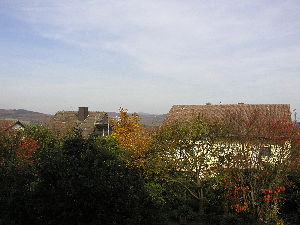
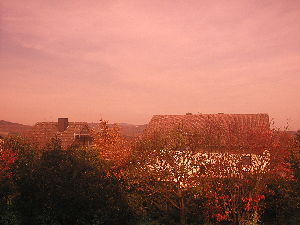
left: Olympus 4040, normal / right: Olympus 4040 with unexposed and developped 35mm negative film.
Not very promising :(

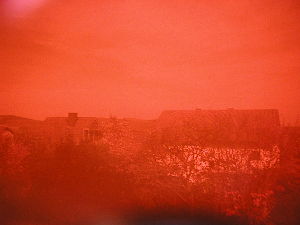
left: Olympus 4040, normal / right: Olympus 4040 with the inlet of an old 3.5" floppy disc.
Not very promising either :(
I'll update when I succeed (or get some unexposed but developed slide film...).
Here's a comparison with the Heliopan 715nm:

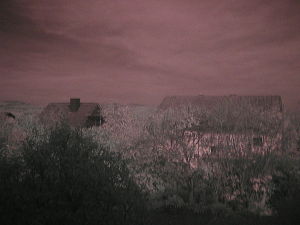
forums.dpreview.com/forums/read.asp?forum=1009&message=10854853
Offer:
If you are near Frankfurt/Main, contact me and I'll do a few test shots with my 715nm filter. I get some data for my IR sensitivity table and you get some info you would not obtain without a proper IR filter. That's a fair deal, or not?
Digital Single Lens Reflex cameras have reached a price level that makes them interesting even for ambitious amateurs. For IR photography, they are kind of a mixed bag. Their image quality is usually very nice (some lenses don't work well in IR, though). But their focussing will sometimes not work correctly, so you have to manual focus them. But you can't easily, because they mostly have no LCD preview and you cannot see anything through the optical viewfinder when the dark/black IR-pass filter is attached. So, to cut it short:
- set up the dSLR without a filter
- frame the scene
- do a manual focus, using the red dot on your lens (this shows were IR light focusses sharp)
- attach the IR-pass filter
- take the picture
- evaluate the display after the shot
- iterate until you are satisfied
- squint your eye to frame the shot
- do auto focus
- take the picture
- evaluate the display after the shot
- iterate until you are satisfied
Here are some pics with my Pentax *ist DS. With the fairly sensitive DS and a mild 715nm filter, I could sometimes shoot handheld and frame the scene with the filter attached.
You may want to check the forums at dpreview.com for more info on IR with dSLRs.
Well, infrared photography with analog cameras is much more difficult than with digital cameras. Firstly, normal chemical film is (nearly) insensitive to IR light. So you need special (expensive) film. This film is not only expensive, it also needs special treatment for storing, inserting and (mostly) development! And it is nearly unforgiving when correct exposure is concerned. So you'll need a SLR with good manual or partly manual controls. Also, you cannot see anything through the viewfinder, as you will have to look through the IR-pass filter you need to use to protect the film from visible light. If you really want to do analog IR photography, I suggest you research this topics on specialized sites like
home.wxs.nl/~losjb/hometest.html
www.art.net/Studios/Hackers/Falk/irnotes.html
www.mat.uc.pt/~rps/photos/FAQ_IR.html
flzhgn.home.mindspring.com/eir.htm
www.apogeephoto.com/mag1-1/mag1-IR.html
and the list goes on.
Please note that my site is not concerned with this topic, but this does not mean I think it is uninteresting. I just think that digital gives _me_ every possibility _I_ want without much hassle. I never understood the analog vs. digital debate. Everyone should pursuit his/her own way to happiness.
As I briefly mentioned above, CCD sensors are at least a bit sensitive to UV light. Normal chemical film is very sensitive to UV light. So, ultraviolet photography is in fact easier with chemical films. But there is one thing you have to keep in mind: All types of normal glass block UV light pretty efficiently. There are specialized UV cut-filters available, but even on film cameras they are most useful when shooting in extreme situations like high mountains. There are special lenses available which let much UV light pass. These consist for example of high-quality plastic or crystals. If you are interested, you could visit, no wait, make that you must visit
Bjørn Rørslett's site www.naturfotograf.com
He has collected what is probably the best site covering anything from UV to IR, both analog and digital. He works with Nikon SLR and dSLR cameras and uses specialized lenses. It is very worth to check out, even if you will never own an SLR.
Scientific and medical applications of UV (plus IR and Fluorescence photography) are described in great detail on http://msp.rmit.edu.au.